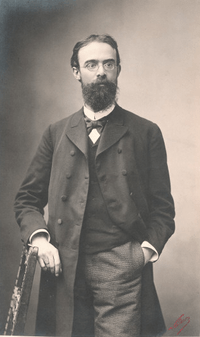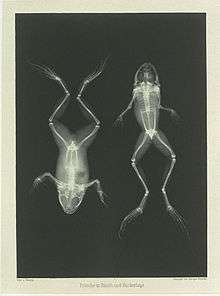Josef Maria Eder
Josef Maria Eder 16 March 1855 – 18 October 1944) was an Austrian chemist who specialized in the chemistry of photography.
Josef Maria Eder | |
|---|---|
 | |
| Born | 16 March 1855 |
| Died | 18 October 1944 (aged 89) |
| Nationality | Austrian |
| Alma mater | Vienna University of Technology |
| Awards | Lieben Prize 1895 |
| Scientific career | |
| Fields | Chemistry of photography |
| Institutions | Vienna University of Technology |

Life and work
Eder was born in Krems an der Donau in 1855. He studied chemistry, physics and mathematics at the Vienna University of Technology and at the University of Vienna. In 1876, he received his PhD and in 1879, after his habilitation, became lecturer at the Vienna University of Technology. His research then was focused on the chemistry of photography. After spending some time at the Staatliche Gewerbeschule Vienna, he became lecturer at the Höhere Gewerbeschule Vienna. This change improved his possibilities for doing research. In the following years, Eder developed sensitized gelatin silver process. Orthochromatic photographic plates, in combination with a color filter counter-acting the plates' inhomogeneous sensitivity to light of different wavelengths, yielded black and white images showing all colors of the light in their true brightness. Eder was a professor at the Vienna University of Technology from 1892 to 1925.[1][2][3] Eder tried to implement science methods into the development of photographic processes. In particular, he used spectroscopy methods and invented several new instruments including the "Eder-Hecht neutral wedge photometer" (with Walter Hecht (1896–1960)). His another invention was the "mercury oxalate photometer" which was a chemical photometer to measure the intensity of UV radiation. After the effect of X-rays on photographic material was published, Eder did research to improve the sensitivity of photographic material to X-rays. By 1884, Eder started writing his Extensive Handbook of Photography, which is still available as reprint.[4] He was awarded the Lieben Prize in 1895[5] and became a member of the Austrian Academy of Sciences in 1930. Eder founded the Institute for Photography and Reproduction Techniques (today the de:Höhere Graphische Bundes- Lehr- und Versuchsanstalt).[2][3][6]
Distinctions
In 1884 he was awarded the Progress Medal of the Photographic Society of Great Britain (known as the Royal Photographic Society (RPS) today).[7]
- Lieben Prize, 1895
- Wilhelm Exner Medal, 1923
References
- Beiträge zur Photochemie und Spectralanalyse. Wien, k.k. graphische Lehr- u. Versuchsanstalt 1904. 4°. Mit 60 tls. gefalt. (einige farb.) Taf. u. 93 Textabb. XII S., 2 Bl., 425 S., 1 Bl., 174 S., 1 Bl., 167 S., 1 Bl., 30 S., 1 Bl., 51 S. Mod. Lwd. using Olwd.
- "Eder, Josef Maria". Österreichisches Biographisches Lexikon 1815–1950. 1. Vienna: Österreichische Akademie der Wissenschaften. 1957. ISBN 3-7001-1327-7.
- Walter Schürmeyer (1959), "Eder, Joseph Maria", Neue Deutsche Biographie (NDB) (in German), 4, Berlin: Duncker & Humblot, pp. 312–313
- Eder, Josef Maria (2009). Ausführliches Handbuch Der Photographie. BiblioBazaar. ISBN 978-1-110-25161-2.
- "Ignaz Lieben-Preisträger 1895: Josef Maria Eder".
- Faber, Monika. "J. M. Eder und die wissenschaftliche Fotografie". Albertina. Retrieved 2010-03-01.
- Royal Photographic Society. Progress medal. Web-page listing people, who have received this award since 1878 ("Archived copy". Archived from the original on 2012-08-22. Retrieved 2013-04-19.CS1 maint: archived copy as title (link)): “Instituted in 1878, this medal is awarded in recognition of any invention, research, publication or other contribution which has resulted in an important advance in the scientific or technological development of photography or imaging in the widest sense. This award also carries with it an Honorary Fellowship of The Society. […] 1884 J M Eder […]”
- The History of European Photography 1900-1938, FOTOFO., 2011. ISBN 978-80-85739-55-8
See also
| Wikimedia Commons has media related to Josef Maria Eder. |
- Improvements to Julius Scheiner's system of measuring film speeds in Scheinergrade.